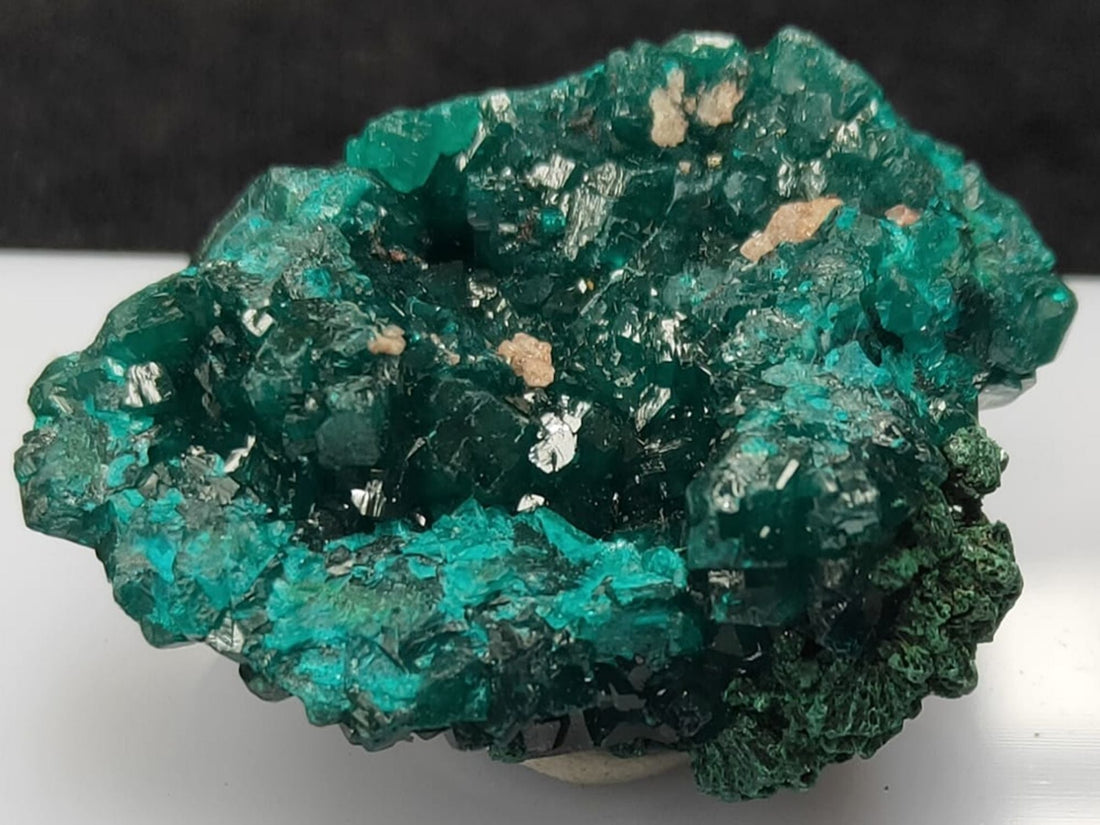
Dioptase: A Gemstone of Vibrant Green Elegance
Share
Dioptase, often referred to as the "Emerald of the Desert," is a captivating mineral celebrated for its intense green hue and brilliance. This rare gemstone has fascinated collectors and scientists not only for its aesthetic appeal but also for its unique formation and chemical properties. Let’s explore the science and allure behind this extraordinary mineral.
Chemical Composition and Structure
Dioptase is a copper cyclosilicate mineral, with the chemical formula CuSiO₃·H₂O. Its crystal structure is composed of silicate tetrahedra (SiO₄) arranged in rings, which are linked by copper ions (Cu²⁺). This intricate framework is responsible for the mineral's vibrant green colour, as the copper ions absorb specific wavelengths of light.
Interestingly, dioptase also contains water molecules (H₂O) within its crystal lattice, which contribute to its stability. Trace elements like zinc, manganese, or iron may occasionally be present, subtly altering its hue. Despite its beauty, dioptase is relatively fragile due to its perfect cleavage, which makes it prone to splitting along specific planes.
Join Our Wholesale Trading Facebook Group Here
Formation and Geological Origins
Dioptase forms in copper-rich environments through secondary hydrothermal processes. These processes occur in the oxidised zones of copper deposits, where chemical reactions between copper-bearing minerals and silica-rich fluids lead to the mineral's crystallisation.
The formation process involves several steps:
-
Oxidation of Copper Minerals: Near-surface copper deposits interact with oxygen, altering their chemical structure.
-
Silica-Rich Fluids: Heated groundwater enriched with silica reacts with oxidised copper minerals, dissolving them and releasing copper ions.
-
Precipitation: Under specific conditions of temperature and pressure, copper ions combine with silica to form dioptase crystals.
This process typically occurs in arid regions, where dry conditions enhance the oxidation of copper minerals.
Notable Deposits
Dioptase is found in several locations worldwide, with some of the most significant deposits including:
-
Kazakhstan: The Altyn-Tyube deposit is renowned for producing deep green, highly transparent crystals.
-
Namibia: The Tsumeb Mine is famous for its well-formed, prismatic dioptase specimens.
-
Democratic Republic of Congo: The Katanga region yields vibrant, richly coloured crystals.
-
United States: Mines in Arizona and New Mexico produce dioptase associated with other copper minerals.
-
Chile: The Atacama Desert provides ideal conditions for dioptase formation, resulting in striking specimens.
Physical Properties
Dioptase has a hardness of 5 on the Mohs scale, making it relatively soft compared to other gemstones. Its perfect cleavage and vitreous lustre give it a glass-like appearance, but also make it delicate to handle. When faceted, dioptase exhibits exceptional brilliance and depth of colour, rivaling that of emeralds.
Uses and Applications
Due to its vibrant colour and rarity, dioptase is highly sought after for jewellery and mineral collections. It is often cut into cabochons or faceted gems, though its fragility requires careful handling. Collectors prize dioptase for its unique crystal formations and vivid green hue, making it a standout addition to any collection.
Fun Fact
The name "dioptase" comes from the Greek words "dia" (through) and "optazo" (to see), referring to the mineral's transparency and the ability to observe its cleavage planes.
Dioptase is more than just a gemstone; it is a testament to the intricate processes of Earth's geology. Its vibrant green colour, complex formation, and rarity make it a true treasure.
Join Our Wholesale Trading Facebook Group Here
References:
Geology Science :https://geologyscience.com/
MDPI: https://mdpi.com/
American Physical Society: https://www.aps.org/

